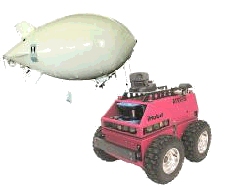Field Robotics: Difference between revisions
No edit summary |
|||
| Line 11: | Line 11: | ||
=== Rescue project: Cooperative Navigation for Rescue Robots === | === Rescue project: Cooperative Navigation for Rescue Robots === | ||
[[Image:Rescue.jpg|frame|ATRV-Jr platform used in the Rescue project]] | |||
This project carried aimed at endowing a team of outdoors robots with cooperative navigation capabilities, so as to demonstrate the ability of the robots to act individually and cooperatively in search and rescue-like operation scenarios. Search and Rescue (SAR) operations are a challenging application for Robotics since, due to their nature, they naturally foster advances in Artificial Vision, Navigation in outdoors unstructured environments, Distributed Artificial Intelligence and Intelligent Control. | This project carried aimed at endowing a team of outdoors robots with cooperative navigation capabilities, so as to demonstrate the ability of the robots to act individually and cooperatively in search and rescue-like operation scenarios. Search and Rescue (SAR) operations are a challenging application for Robotics since, due to their nature, they naturally foster advances in Artificial Vision, Navigation in outdoors unstructured environments, Distributed Artificial Intelligence and Intelligent Control. | ||
Revision as of 00:14, 3 January 2009

Introduction
ISLab has been developing, together with the Mobile Robotics Lab, and under the Theme B of ISR - Associate Lab, field robotics activities and applications, motivated by their novel scientific and technical challenges (such as the cooperation among land and aerial robots, and among robots and humans, in unstructured, frequently outdoors, scenarios), relevance for public policies, and potential for innovative results on unstructured environments blending sound theory and technological developments. The work has been driven so far by applications to search and rescue, as well as urban, scenarios.
Research activities
Initial work in field robotics comprised Search and Rescue (S&R) scenarios as a unifying testbed for diverse research approaches, ranging from the construction of new platforms, up to high-level coordination of mixed initiative human/robot teams. This sections enumerates these activities in a chronological sequence.

This project carried aimed at endowing a team of outdoors robots with cooperative navigation capabilities, so as to demonstrate the ability of the robots to act individually and cooperatively in search and rescue-like operation scenarios. Search and Rescue (SAR) operations are a challenging application for Robotics since, due to their nature, they naturally foster advances in Artificial Vision, Navigation in outdoors unstructured environments, Distributed Artificial Intelligence and Intelligent Control.
The long-term objectives of the project consist of applications to SAR under large-scale catastrophe scenarios, namely after an earthquake. However, the current proposal is focused on the first steps towards the long-term goal and, as such, it refers to simpler scenarios and is based on some simplifying hypotheses, such as daylight operation and pre-planned robotic tasks. Also, the robotic team will include only 2 robots, purposively made heterogeneous, both regarding the functional, hardware and software architectures: one wheeled and one aerial robot. Therefore, each type of robot can be assigned tasks with different requirements under SAR operations.
The following is a list of problems that will be addressed and, at least partially, solved during the current project:
- Definition of a functional architecture suitable for the integration of the subsystems composing the robotic team, oriented towards SAR applications.
- Choice of the appropriate sensors and sensor fusion methodologies.
- Issues concerning topological, world-model-based and sensor-based navigation within unstructured environments, as well as their extension to cooperative navigation, where 2 robots communicate with each other to share information relevant for team navigation improvement.
- Task coordination, including the appropriate integration of the functional subsystems and resources management during the execution of a given robotic task.
Project link: http://rescue.isr.ist.utl.pt
Robotic platforms